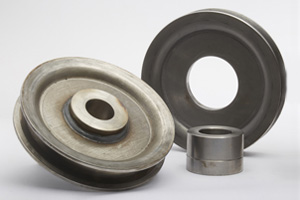Wire rope sheaves, also known as pulleys or blocks, serve various purposes in mechanical systems that involve the use of wire ropes or cables. These components are essential for transmitting force and changing the direction of a wire rope. Here are some common purposes and uses of wire rope sheaves:
- Directional Change:
- One of the primary purposes of wire rope sheaves is to change the direction of the wire rope. By passing the rope around the grooved circumference of the sheave, the force can be redirected, allowing for more versatile and efficient routing of the cable.
- Force Transmission:
- Wire rope sheaves transmit force and load between two points. When a force is applied to one end of the wire rope, the sheave helps distribute this force to achieve the desired mechanical action, such as lifting, pulling, or tensioning.
- Mechanical Advantage:
- Sheaves can be used to create mechanical advantage in systems like block and tackle arrangements. By incorporating multiple sheaves and rerouting the wire rope through them, a mechanical advantage is achieved, enabling users to lift or move heavier loads with less effort.
- Load Support:
- Sheaves are employed in systems that involve the support and movement of heavy loads. Examples include cranes, hoists, and lifting equipment. The sheave helps support the weight of the load and facilitates its controlled movement.
- Cable Guidance:
- In systems where wire ropes need to follow a specific path, sheaves guide and control the movement of the cables. This is crucial for maintaining proper alignment and preventing excessive wear on the wire rope.
- Tensioning:
- Sheaves are used in tensioning systems to apply and maintain tension in wire ropes. This is common in applications such as elevators, where proper tension is critical for safe and efficient operation.
- Cable Support and Protection:
- Sheaves provide support and protection to the wire rope, preventing it from coming into contact with abrasive surfaces and minimizing wear. The grooves on the sheave’s surface are designed to accommodate the diameter of the wire rope.
- Controlled Movement:
- Sheaves are integral components in systems that require controlled movement, such as in the rigging of sailboats. They help in managing the tension and direction of the cables for precise and controlled maneuvers.
- Adaptation to Different Diameters:
- Sheaves are available in various sizes and designs to accommodate different wire rope diameters. This adaptability makes them suitable for a wide range of applications.
- Maintenance of Wire Rope Integrity:
- Properly designed and maintained sheaves contribute to the longevity and integrity of the wire rope by minimizing abrasion, reducing fatigue, and preventing kinks or twists.
In summary, wire rope sheaves play a crucial role in facilitating the movement, control, and transmission of force in systems that use wire ropes. Their design and configuration depend on the specific requirements of the application in which they are used. You can visit Bear Equipment to learn more about wire rope sheaves from industry experts.
